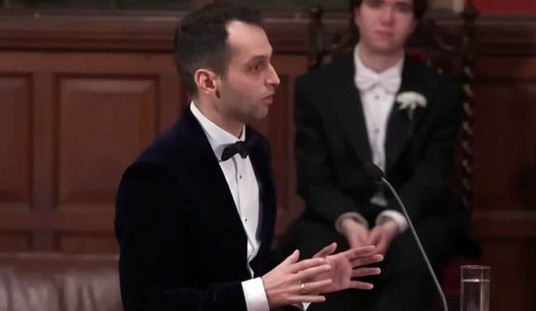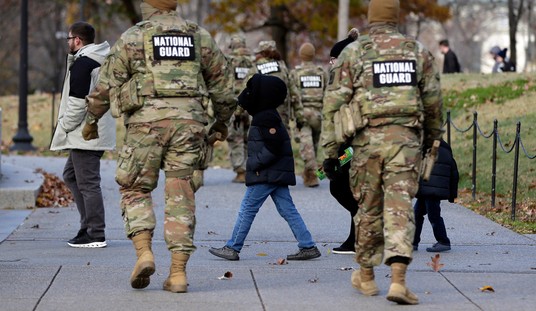A Twitter pal watched the body-cam footage below and remarked that it’s striking how the cops keep trying to escalate the situation while the military man does the opposite. Maybe that’s a function of training, maybe it’s a function of personality, maybe some of both. But for six long minutes, it is what it is.
The good news about this incident, unlike most other clips of police traffic stops that go viral, is that no one dies. In fact, no one was arrested: Caron Nazario, the officer who was pulled over and then pepper-sprayed, was let go at the scene. The video is circulating because Nazario filed a lawsuit in Virginia this week accusing the two officers of having violated his constitutional rights by treating him the way they did. I watched it before I read up on what happened and was struck by how aggro the cops were from the start. What could Nazario have done behind the wheel to freak them out so much that they had guns drawn when he pulled over? He’s so calm when he finally speaks with them that he seems almost sedate.
But there’s a reason for that, it turns out, and it’s not that Nazario is preternaturally chill. He’s clearly scared out of his wits that one of these amped-up cops is going to flinch and blow him away by misinterpreting something he’s doing as threatening. It’s happened before, as I’m sure he’s aware. Let’s pause here so you can watch the clip. The first 90 seconds are just footage from inside the police cruiser while they’re in pursuit; the encounter begins at around 1:30.
“I’m honestly afraid to get out,” says Nazario when the cops first start shouting at him. “You should be,” says one, warning him that he might “ride the lightning” if he doesn’t comply, which I assume is a threat to tase him. From the beginning, the cops have put this guy in mortal fear of being harmed. Not a productive way to start a traffic stop.
But back up. The cops are clearly afraid too. Guns out, high adrenaline. How come? Quote:
Windsor Police Officer Daniel Crocker radioed he was attempting to stop a vehicle with no rear license plate and tinted windows. He said the driver was “eluding police” and he considered it a “high-risk traffic stop,” according to a report he submitted afterward and which was included in the court filing.
Sounds like they thought they were in pursuit of a stolen vehicle. A car thief in a situation like that, on the brink of being caught, might panic at the prospect and do something desperate to try to evade arrest.
There are problems with that explanation, though. First, according to the lawsuit, Nazario’s car didn’t lack rear plates. It was a new car and had a temporary plate taped to the back window, which the cops should have been able to see as they got closer. Nazario wasn’t really “eluding” police either. Crocker’s own report admitted that he was traveling at low speed; this wasn’t a chase at 100 mph with the driver frantically trying to outrace police. The reason Nazario didn’t pull over immediately, it seems, is that he didn’t want his encounter with the cops to happen on a poorly lit roadside — a not uncommon response according to one of the cops involved:
Another officer, Joe Gutierrez, was driving by when he heard Crocker’s call, saw him attempting to stop the SUV and decided to join the traffic stop. Gutierrez acknowledged that Nazario’s decision to drive to a lighted area happens to him “a lot, and 80% of the time, it’s a minority,” Arthur said, quoting the officer.
I can think of two reasons why minorities might want their encounters with cops to happen in well-lit areas. One is that they fear they might be deliberately mistreated and suspect that a well-lit area where bystanders are more likely to be around to witness it will make the cops think twice. The other is that their own actions can be more easily misconstrued as so-called “furtive movements” when the lighting is dim. Nazario is petrified about that in the video despite the bright lighting. Even after Gutierrez has hooted at him repeatedly to unbuckle his seat belt and step out, Nazario makes sure to tell him that he’s about to do so before moving a muscle. He’s obviously thinking that if he moves his arm without letting the cops know why first, they’re going to assume he’s going for a gun and kill him right there. They give him contradictory orders at one point too, telling him to show them his hands but also telling him to open the door. All he has to do is make one false move and he’s dead. And he’s palpably aware of it every second of this encounter.
If you believe his lawsuit, the police realized at some point after the footage ends that they had handled this poorly and had no grounds for arrest because suddenly they were eager to go easy on him — provided that he kept his mouth shut:
“Realizing that they had acted illegally,” the lawsuit says, the officers told Nazario that if he “would chill and let this go,” they would release him without filing any charges. But if he fought it, which Gutierrez acknowledged he had the right to do, Nazario would be charged and would have “to go to court and notify his command.”
Afterwards, the two officers filed reports with “near identical” misstatements, the lawsuit says.
They reported that Nazario refused to show his hands and slapped theirs away when they tried to get him out. Gutierrez wrote that he gave knee strikes to Nazario’s legs because he wouldn’t get on the ground and resisted arrest.
Specifically, they warned Nazario that they would charge him with “obstructing justice, eluding police, and assaulting a law enforcement officer” if he made a stink about it, according to the complaint. Gutierrez claimed in his police report that they ultimately went easy on him because they didn’t want an arrest and prosecution to ruin his military career, a curiously considerate gesture from an officer who had just repeatedly pepper-sprayed Nazario in the face and threatened to tase him.
Some cohort of people believes that when a police officer gives you an order, reasonable or not, you obey that order and if you don’t then anything that happens to you is your own fault. For the rest of us, though, we’re left with a question after watching the clip: What’s the proper way to get a driver to step out of a vehicle when he doesn’t want to step out? It can’t be pepper-spraying him in the face six times or whatever, can it? One possibility, which I’m sure would be Nazario’s answer, is that there was never a valid reason to make him step out in the first place. It was a traffic stop and he hadn’t done anything wrong. But let’s say for argument’s sake that the cops did have a valid reason, that they sincerely believed the car might be stolen and feared he might have a weapon. How do you get him out when he doesn’t want to step out yet isn’t behaving in any sort of threatening way, not even raising his voice?









Join the conversation as a VIP Member